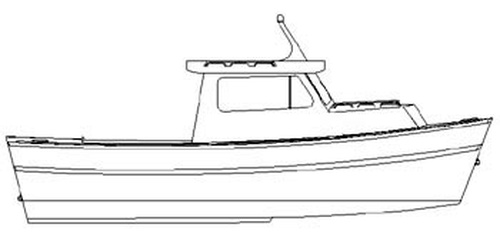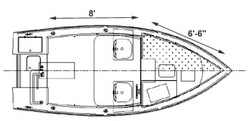Harbor Master 19 by Bateau.com
[HM19] Small but able outboard cruiser based on a dory style hull
| Length overall | ||
|---|---|---|
| Beam | ||
| Draft | ||
| Berths | 2 | |
| Weight | ||
| Displacement | ||
| Engine power | 10 - 55 | |
| Hull construction | Stich-n-glue | |
| See also | Outboard Dory 18, Harbor Master Displacement 19, Pilot 19, Pilot 21, Open Pilot 21, Novi 23, Down East Cruiser 23 | |
| compare | ||
URL: http://www.bateau.com/proddetail.php?prod=HM19
Description:
The HM19 is the response to repeated requests for a cabin version of the successful OD18. The OD18 (Outboard Dory 18') is not your regular power dory: it's a flat bottom planing hull with a beveled chine to avoid tripping, a well defended high bow and a nice classic sheer line. The OD18 owners and builders love her lines but the addition of even the smallest cabin would have destroyed her well-balanced proportions. As the designer, I refused to consider the change until somebody suggested having a look at the C-Dory 16, a fiberglass production boat with a small pilothouse and cabin. The enthusiasm of the message board users was such that I did some sketching. We kept the same basic hull than the OD18 but changed the sheer line and added a cabin and pilothouse. The result was a very different looking boat and her commanding looks inspired the name Harbor Master.
Performance
Calculations by the Crouch formula show that with a 50 HP, she will go between 24 and 28 mph depending on the load. A 70 HP can be used but per USCG calculations, 55 HP is the maximum that should be installed with remote steering unless the capacity tag identifies her as "experimental". A 10 HP is more than sufficient to push her at displacement speeds for those who prefer a more tranquil pace.
This boats transom is designed for a standard 20" shaft. The transom can easily be modified to accept other shaft lengths.
Layout
One can't offer standing headroom in that size boat without compromising stability and looks. An ugly boat is not worth building. Some believe that boxy hulls have hidden qualities or are easier to build: not true. Looks and behavior go together: if she is pretty, most of the time she will handle well. If she is a bad boat, she usually looks like it. The pilothouse is just right: one can sit with good clearance above his head but see above it when standing in the cockpit.
From stern to bow
Large lockers on each side of the motorwell can be used for storage or bait well. The self-bailing cockpit sole is high enough to stay above the waterline until the displacement reaches 3,300 lbs.
Under the cockpit floor, we show an 18 gallons fixed fuel tank, ideal for a four-stroke engine but if you need more range, there is room for a second tank. The fuel tank fittings end up under the motorwell to make connections and access to a fuel filter as easy as possible: no need for chase tubes, easy installation of all hoses. A fixed fuel tank is not required however: two portable tanks can be installed under the seats with room to spare.
Under the nicely cambered pilothouse roof, the rear frame of the pilothouse doubles as a grabrail. The skipper will find enough room in front of the wheel to mount electronics and we use the extension of the cabin roof as a dashboard. The same surface on the port side can be a small chart table.
Access to the cabin is through an open companionway but feel free to install a sliding hatch. The vee berth is 6' 6" long and a Porta-Potti slides under the mid section. On deck, the 8" wide gunwales extend all along the pilothouse and cabin side. Handrails on each roof helps circulation forward. A small toe rail runs all long the sheer line.
Options
There is room for a bench in the rear if one needs more seating.
Under the gunwales, the frames can be cut to act as rod holders. There is ample storage room in the seat boxes: they extend all the way to the hull sides. With the proper foam insulation, a seatbox can be used as an ice box.
The pilothouse can be partially or completed closed with Plexiglas or Lexan but builders should keep the size of the boat in mind and not make the topsides too heavy or excessively increase windage. Framed or hinged windows are possible but keep them light.
We show a small hatch in the roof for light and ventilation, no portholes but they are easy to add.
The HM19 can be made unsinkable with expandable buoyancy foam under the sole while foam sheets glued under the gunwales will guarantee upright floatation.
See also
Boats about same size as Harbor Master 19

|
Harbor Master Displacement 19
[HMD19] Evolution of the HM19 with a true displacement hull that is suited for lower speed
|
|
Redwing 18
Power camp cruiser
|

|
Classic 19 Express
[CX19] A cabin version of C19
|
Questions? Suggestions? Contact us at: info@boatplans.cc


